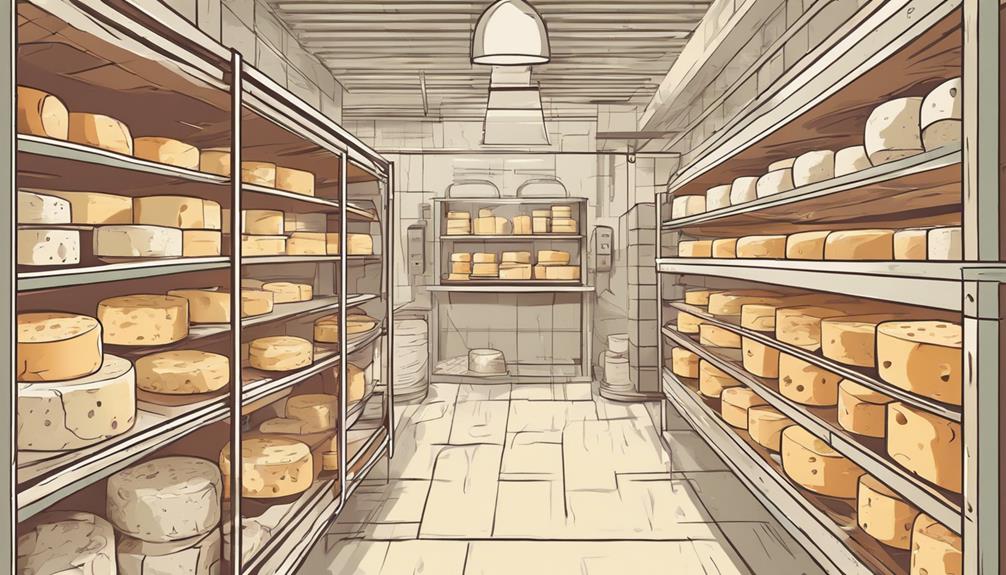How To Become More Self-Sufficient Without Starting a Full-Blown Farm…
Want to start preserving your harvest, making your own soap, or building a backyard root cellar — but not sure where to begin? “Homesteading Advice” gives you instant lifetime access to 35+ practical homesteading books on food preservation, veggie gardening, DIY natural cleaning products (save over $250 per year with this skill alone), brewing, off-grid energy, and a whole lot more…
Click Here To Check It Out Now!
“I’ve been maturing a batch of Gouda in my little cheese cave here in Fargo, North Dakota. Recently, I’ve noticed some unusual cracking and uneven texture developing. I’m worried something might be going wrong. What are the common issues in aging cheese, and how do you fix them?” Thanks, Patrick, Fargo, USA.
Common Issues in Aging Cheese, And How to Fix Them
Hey Patrick! Aging cheese can be such an exciting yet intricate process. Each type can throw a few curveballs, but that’s part of the adventure, right? Let’s walk through some of the more common issues you might encounter while aging cheese and how you can tackle them.
1. Cracks Developing in the Cheese
Cracks in your cheese can be pretty disheartening. They often stem from several factors:
- Temperature Fluctuations: When the aging environment isn’t stable, the cheese can expand and contract, leading to cracks.
- Humidity Levels: If the humidity is too low, the cheese can dry out and crack.
- Handling: Rough handling while flipping or moving the cheese can also cause cracks.
Fixing It: Patrick, ensure your cheese cave maintains a consistent temperature, ideally between 50-55°F. Humidity should be around 85%. A small humidifier can help maintain the right levels. Handle cheese gently when flipping to avoid mechanical stress.
2. Uneven Texture
Uneven texture might make you frown, but understanding its causes can help:
- Inconsistent Curd Cutting: Unequal curd sizes can lead to non-uniform moisture content.
- Inadequate Pressing: Not pressing the cheese with consistent pressure can result in an uneven texture.
- Temperature Inconsistency: Variations during aging can affect texture.
Fixing It: Cut curds as uniformly as possible. During pressing, ensure even pressure distribution. Double-check your cave’s temperature stability to keep things consistent.
3. Mold: Friend or Foe?
Ah, mold – inevitable but manageable.
- Unwanted Mold: While some molds are desired, unwanted varieties can wreak havoc on your cheese.
Fixing It: Regularly clean your aging space with a mild vinegar solution to inhibit unwanted mold growth. If it shows up on the cheese, just scrub it off with a brine-soaked cloth. If it’s stubborn, a stronger brine with a touch of white vinegar often does the trick.
4. Ammonia Smell
Nobody wants their cheese smelling like a cleaning product. This often results from:
- Poor Air Circulation: When air doesn’t move well, ammonia can build up from bacterial activity.
Fixing It: Improve ventilation in your cheese cave. Proper circulation helps prevent this problem. Flipping the cheese periodically also aids airflow around the blocks.
5. Bitter Taste
Certain cheeses develop bitterness due to various reasons:
- Over-Acidification: Initial curd production might result in bitterness if acidity goes unchecked.
- Proteolysis: Excessive protein breakdown during aging causes bitterness.
Fixing It: Monitor pH levels carefully during the initial stages. Make sure to age your cheese under the right conditions to avoid protein breakdown issues.
6. Bulging Cheese
Bulging is often related to gas formation:
- Gas-Producing Bacteria: Infections or unintentional bacteria can cause gas formation within the cheese.
- Starter Culture Imbalance: An imbalance can also give rise to gas production.
Fixing It: Use high-quality and tested starter cultures strictly. Maintain your equipment clean and sanitized to avoid unwanted bacterial introduction.
7. Slime on the Surface
A slimy surface can be troublesome. Typically caused by:
- Excess Moisture: High humidity can lead to a slimy rind.
Fixing It: Adjust humidity levels to the proper range. Frequent wiping with brined cloth can help manage surface slime.
8. Rind Separation
The rind separating from the cheese can be due to:
- Too Rapid Drying: If the outside dries faster than the inside, separation can occur.
Fixing It: Ensure slower, even drying. Adjusting the humidity and aging environment can prevent outer area from drying too quickly compared to the inner parts.
9. Color Changes
Color changes can be alarming but aren’t always a disaster:
- Light Exposure: Direct light can alter cheese color.
- Bacterial Action: Some bacterial actions might cause color issues.
Fixing It: Store cheese in a dark place, possibly wrapping it in cheese paper or waxed paper. Maintain a hygienic environment to ward off unwanted bacterial activity.
10. Crystals Formation
Those crunchy bits in aged cheese! Here are potential causes:
- Amino Acid Tyrosine: Naturally forms as proteins break down.
- Lactate Crystals: Common in aged cheeses.
Fixing It: Mostly, crystals are a sign of well-aged cheese, often found desirable. If not, ensuring proper moisture and aging conditions might help manage them if deemed undesirable for your cheese variety.
Final Thoughts…
Patrick, thanks for reaching out from Fargo. Aging cheese is a delicate but rewarding craft. Remember, cheese is a living product, and sometimes these quirks add character. Keep an eye on your environment, maintain consistent practices, and don’t worry too much if things go a bit off-script. Every batch teaches a new lesson. Happy aging, and may your cheese be ever delicious!

